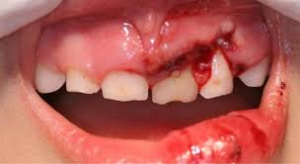Injured primary incisors
If your child has suffered an injury to one (or more) of the primary incisors. This page is intended to help you understand what you can expect to happen. Plus, what may occur that indicates that the tooth is taking a less favorable course.
You can expect the following reactions:
Change in color of the tooth
The tooth (teeth) will probably darken over a period of time, eventually turning quite dark. Usually, the color will be a charcoal gray; although it may be brown, yellow or a lighter color as well. Eventually, it will begin to lighten again, returning to a color similar to how the tooth appeared before the injury, but not quite as snow white.

Looseness
The bone that supports the tooth has been expanded by the injury, which will make the tooth looser than normal. As the bone returns to a normal position, the tooth will also tighten up again.
Bleeding and swelling
As with any injury, the normal reaction of the injured tissues (in this case, the gums and/or lips) will bleed and/or swell. An ice pack (a cold washcloth is good) will help decrease that swelling and a warm salt water rinse will promote healing of any cuts.

Pain
Fortunately, children do not usually suffer from much pain when they have teeth injuries. Occasionally there will be pain if the child tries to chew with the injured tooth. But as with any injury, the area should be “babied” to avoid aggravating the injury.
You should watch for any of the following:
- Change in eating or sleeping habits. If your child’s normal eating patterns change (in particular, if they complain when chewing or drinking something cold) or if your child is not sleeping, another checkup is appropriate.
- Gum boils. These will appear on the gums in the area where the gums and lips meet. Gum boils look like a small blister or a pimple on the gums.
- Increased swelling, looseness or pain. If any of the “expected reactions” become worse, the area should be re-examined.
When in doubt, do not hesitate to call our office about your child.
Read our post on how to prevent sports-related injuries.


